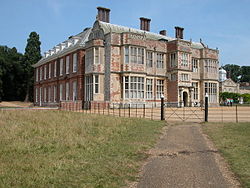Felbrigg Hall
| Felbrigg Hall | |
|
National Trust | |
|---|---|
 Felbrigg Hall | |
| Grid reference: | TG193394 |
| Information | |
| Website: | Felbrigg Hall |

Felbrigg Hall is a 17th-century country house at Felbrigg in Norfolk, owned by the National Trust.
This is a remarkably unaltered 17th-century house, noted for its Jacobean architecture and fine Georgian interior. Outside the house are a walled garden, an orangery and orchards.
History
Felbrigg estate, originally home to the Felbrigg family, was long the home of members of the Wyndham family, since the first John Wyndham (d. 1475), acquired the estate from the Felbrigg family. Thomas Wyndham (d. 1522) was a councillor to King Henry VIII. Later residents included John Wyndham (1558–1645), probably the builder of Felbrigg Hall. The last Wyndham of Felbrigg was William Wyndham (d. 1810).
The last owner of the house before it passed into National Trust ownership was Robert Wyndham Ketton-Cremer after the original heir, Robert's brother Richard, was killed in action in the Second World War. A memorial to Richard Ketton-Cremer was constructed in the woods behind the house by Robert.
Robert Wyndham Ketton-Cremer wrote a number of books, particularly about Norfolk, including Felbrigg: the Story of a House,[1] and Norfolk in the Civil War, Faber, 1969. [2] In the latter, he indicates his health is failing. Robert Ketton-Cremer never married, and with no heirs, left the estate to the National Trust on his death in 1969. Part of the estate was acquired by the Beeston Hall School.
Christopher Mackie, husband of author Mary Mackie, was administrator, or houseman, of Felbrigg Hall until 1990. Mary Mackie has written a number of books on their experiences, the most successful of which are Cobwebs and Cream Teas and Dry Rot and Daffodils.
Today
At one time Felbrigg Hall stood at the centre of one the largest estates in Norfolk. Today 2011, the Felbrigg estate covers some 1,760 acres of parkland including the 520-acre Great Wood, which shelters the house.
Public access
There are a number of waymarked walks through the estate, including the Weavers' Way long distance footpath. National Cycle Network regional routes 33 and 30 pass through the estate. [3]
The gardens
Felbrigg garden is laid out in two different styles. The west garden is laid out in the style of a typical Victorian pleasure ground, arranged around an 18th-century orangery. Accentuating the play between light and shade, its formal lawns are interspersed with areas of dark shrubbery. This garden features a number of specimens from North America including Red Oaks, Western Red Cedars, and a meadow with a walled garden. There are double borders of mixed shrubs, a herbaceous border, and more. The orchard has been planted with varieties of fruit known to have grown in the garden during the 19th century. The gardens are home to the National Collection of Colchicums.
| ("Wikimedia Commons" has material about Felbrigg Hall) |
References
- ↑ WorldCat OCLC Number: 6325329
- ↑ Norfolk in the Civil War Retrieved 10 August, 2013
- ↑ Sustrans Retrieved 9 August, 2013
- AA's Illustrated Guide to Britain, London, 5th edition, 1983.
- Mackie, Mary. Cobwebs and Cream Teas: Year in the Life of a National Trust House, ISBN 0-7528-3410-X
- Mackie, Mary. Dry Rot and Daffodils: Life in a National Trust House, ISBN 0-7528-3409-6
- Mackie, Mary. Frogspawn and Floor Polish: Upstairs and Downstairs in a National Trust House, ISBN 1-84024-333-3